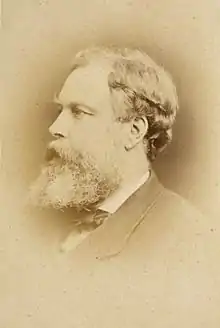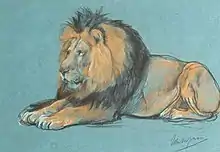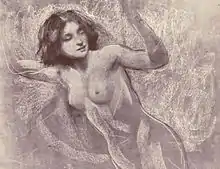John Macallan Swan
John Macallan Swan RA (9 December 1846 – 14 February 1910) was an English painter and sculptor.

Biography
Swan was born in Brentford, Middlesex, on 9 December 1846. He received his art training first in England at the Worcester and Lambeth schools of art and the Royal Academy schools, and subsequently in Paris, in the studios of Jean-Léon Gérôme and Emmanuel Frémiet. He began to exhibit at the Academy in 1878. His picture The Prodigal Son, bought for the Chantrey collection in 1889 (and now in the Tate Britain), established his reputation as an artist. He married artist Mary Rankin Swan in Ireland in 1884 and had two children with her, including sculptor Mary Alice Swan.[1]
He was elected associate in the Royal Academy in 1894 and academician in 1905. He was appointed a member of the Dutch Water-Colour Society in 1885; and associate of the Royal Society of Painters in Water Colours in 1896 and full member in 1899. He was awarded first class gold medals for painting and sculpture in the Paris Exhibition, 1900.
Work

A master of the oil, water-colour and pastel mediums, an accomplished painter and a skilful draughtsman, he ranks also as a sculptor of distinguished ability, having worked in nearly every material. He has treated the human figure with notable power, but it is by his representations of the larger wild animals, mainly the felidae, that he chiefly established his reputation; in this branch of practice he has scarcely a rival.
Painting
His subjects in oil include animals, figures, and landscapes, and are distinguished by massive, simple treatment, and a strongly imaginative element. Noted examples include:
- Ocelot and Fish
- Tigers
- Tigers Drinking
- Ceylon Leopards
- Lions
- Lioness Defending Her Cubs
- Polar Bear Swimming

Sculpture

The modeling in his sculptured works is broad, flexible, and naturalistic. Here he has been compared with Antoine-Louis Barye. Noted examples include:
- The Jaguar
- Puma and Macaw
- Wounded Leopard
- Leopard Running
- The eight bronze lions and bust of Cecil Rhodes at Rhodes Memorial in Cape Town, South Africa
Notes
References
- "Biographical information". V&A's collections.
- Gilman, D. C.; Peck, H. T.; Colby, F. M., eds. (1905). . New International Encyclopedia (1st ed.). New York: Dodd, Mead.
- Attribution
- This article incorporates text from a publication now in the public domain: Chisholm, Hugh, ed. (1911). "Swan, John Macallan". Encyclopædia Britannica (11th ed.). Cambridge University Press. This work in turn cites:
- A. L. Baldry, "The Work of J. M. Swan" in The Studio, vol. xxii.
- Drawings of John M. Swan, R.A. (George Newnes, Ltd.)
External links
- 16 artworks by or after John Macallan Swan at the Art UK site
- Works by John Macallan Swan at the Art Renewal Center
- The Prodigal Son (Tate collections)
- Profile on Royal Academy of Arts Collections
- Boy Piping to the Fishes
- Buried at St John's Churchyard, Niton, Isle of Wight Archived 4 March 2016 at the Wayback Machine
